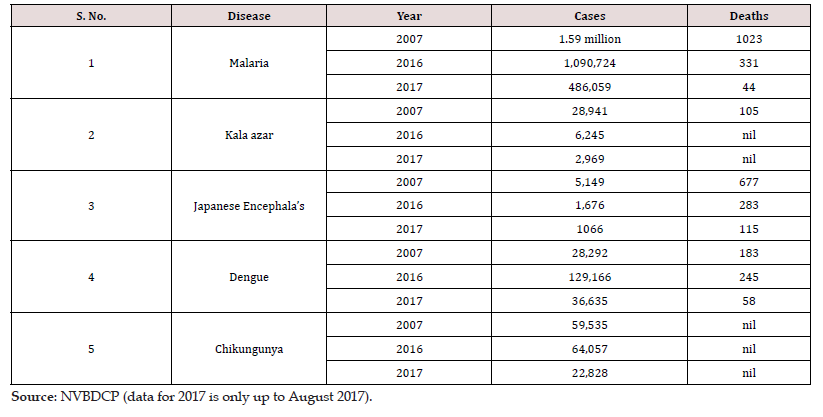
Lupine Publishers Group
Lupine Publishers
Menu
Mini reviewOpen Access 
Impact of climate Change on Human Health in India: Issues and Priority Concerns Volume 2 - Issue 3
R S Goyal*
- Former, Dean, Institute of Health Management Research, Himgiri Zee University, India
Received: April 27, 2023; Published: May 04, 2023
Corresponding author: Former, Dean, Institute of Health Management Research, Jaipur & Himgiri Zee University, India
DOI: 10.32474/JBRS.2023.02.000141
Abstract
This paper analyses the impact of climate change on the human health by taking India as a case. It examines the key aspects of climate change that are perilous to the health of people, how these are mediating their reach, what are their impacts, and to what effect. This research is based on secondary data culled out from reports, surveys and other relevant publications. The impact of climate change is considered in the context of rise in earth’s temperature. Health outcomes related to communicable and noncommunicable, and nutrition are examined. The analysis notes that climate change is impacting the health of people in several ways both directly and indirectly. It is mediating through increasing temperatures which in turn affecting rising sea levels, water and food supply impacts, extreme weather events like heat waves, excessive rains, floods, droughts, etc. Direct effect of environmental circumstances leads to diffusion of vector-borne, water-borne and cardiovascular diseases, respiratory allergies and malnutrition. The recent increase in the spread of vector born diseases, heatwaves, excessive rains, floods, droughts, etc. in the country are largely attributed to climate changes. Research further indicates that millions of Indians are at the risk of becoming nutrient deficient by 2050, as rising levels of carbon dioxide are making staple crops such as rice and wheat less nutritious.
Keywords: Climate change, water borne diseases, environment; dengue; malaria
Introduction
Global reports have suggested that India is among the nations highly vulnerable to the impact of global warming. It supports 17% of world population on just 2.5% landmass and 4% of water share. Further, by virtue of its location in tropical climate zone, a large population base, a huge proportion of whom is living below poverty line in adverse living conditions, India faces a big challenge due to turbulence in weather patterns. Human health is the primary target and most affected by these changes [1]. This paper analyses impact of climate change (largely infused by global warming) on the health of people in India. It examines the key aspects of climate change that are perilous to the health of people, how these are mediating their reach, what are their impacts, and to what effect. Irony of climate change is that most damage to earth’s climate is caused by developed countries by high emission of greenhouse gases, but its consequences are faced more by people in developing countries particularly, in thickly populated tropical climatic zone and living in poverty conditions [2].
Global warming is a long-term rise in the average temperature of the earth’s climate systemmainly caused by human activities. Many observed changes since the mid-20th century have been unprecedented compared to records over decades to thousands of years earlier. It is noted that besides greenhouse gases, factors like deforestation, pollution, overuse of chemical substances in everyday life etc. also contribute to this phenomenon. According to Inter-governmental Panel on Climate Change (IPCC) 2013, the globally averaged combined land and ocean surface temperature data as calculated by a linear trend, show a warming of 0.85 [0.65 to 1.06] °C, over the period 1880 to 2012. It further notes that if the nations of world do not take urgent action, the warming pattern will only expedite. What are the consequences of climate change or rise in earth temperature in particular? How does it affect us? The impact of global warming is mediated through extreme weather events like heat waves, excessive rains, floods, droughts, rising sea levels, water and food supply impacts or other similar factors. India, with its diverse geography comprising of mountains, coasts, forests, deltas and deserts divers is highly vulnerable to climate change.
It is experiencing climate change related threats/changes like glacial melts, rising sea levels, extreme heat waves, droughts, desertification, floods, storms and loss of farmlands, grasslands, biodiversity, and marine ecosystems. These extreme weather events are also amplifying occurrence of heat strokes. Secondly, it is observed that the poorest people in the poorest countries expected to be the worst affected due to climate change, a high absolute number, as well as a large proportion of the world’s poor population also augment the India’s vulnerability to this effect. Nearly 35 per cent of the World’s poor live in the region. About 18.8 of the population in South Asia survives at less than 1.9 $(2011) a day. Further, the prevalence of undernourishment in the region is also high at nearly 16 per cent. In recent decades, there is significant increase in intensity of rainfall events in several parts of India and glacier lake outburst floods in mountainous regions causing huge floods killing thousands of people, displacing millions of people not counting the loss to physical assets, every year.
On the other hand, the numbers of Monsoon deficient districts are increasing with every passing year, ushering in drought scenario. The number of heat wave spells has sharply increased in the last few years. According to Annual Report (2018-19) of Ministry of Environment, Forests and Climate Change (Govt. of India), between 2010 and 2016, the country has witnessed a total of 178 heat wave bouts, but in 2017 alone India suffered 524 heat wave spells. The worst-affected states were Rajasthan, Madhya Pradesh, Maharashtra and Andhra Pradesh where a total of 297 heat wave spells were experienced in 2017. Increasing water scarcity in most parts of the country is creating emergency like situation particularly in summer months, leave alone the quality of water being made available. All these changes have created conducive environments for numerous health consequences including increase in spread of vector-born, communicable and non- communicable diseases and, malnutrition, reduced food production as well as decline in nutrition value of staple foods.
Millions of Indians are at the risk of becoming nutrient deficient by 2050, as rising levels of carbon dioxide (CO2) are making staple crops such as rice and wheat less nutritious [3]. So far, a decline between 10 to 14 % is seen. Researchers at Harvard TH Chan School of Public Health also found that India would bear the greatest burden, with an estimated 50 million people becoming zinc deficient. As many as 38 million people in India are at the risk of becoming protein deficient, and 502 million women and children becoming vulnerable. Child stunting is projected to increase by 35% by 2050 compared to a scenario without climate change. This research notes that decisions we are making every day -- what we eat, how we move around, what we choose to purchase -- are making our food less nutritious and imperiling the health of other populations and future generations. Rising temperature has significantly influenced the spread of vector borne diseases in the country. Dengue and Chikungunya have been on the rise, burden of Malaria has shown a slight decline for now (Table 1).
In arid and semiarid regions of India, where malaria is epidemic, rainfall variability has been shown to drive the interannual variability of the disease and was the basis of one of the first early-warning systems for the disease in this region. Evidence suggests that rainfall variability plays an important role and that a long-term trend in increasing temperature during the 20th century is sufficient to significantly increase the abundance of vectors. Monthly parasite incidence was positively correlated with temperature, precipitation, and humidity. The implications of this association as it relates to long-term climate change remain an important open question. For other regions of India, monsoonal rains have shown an increase in the frequency and magnitude of extreme rain events, whereas the frequency of moderate events has been decreasing, with no significant change in the mean in the last 50 years. Temperature plays a major role, especially at high altitudes, preventing epidemic malaria from spreading into the highest altitude regions.
The consequences of climate change in highland regions are an important open question based on future temperature predictions in these regions. Little is known about the influence of climate variability or climate change on the prevalence of malaria in Indian urban areas. The issue of urban malaria becomes even more important when considering the rapid expansion of urban and semi -urban areas, water storage techniques, and a large proportion of people living in unhealthy environmental conditions. These diseases are also likely to spread into areas where colder temperatures had previously limited transmission. Heat waves are likely to result in a very substantial rise in mortality and death, and injuries from extreme weather events are likely to increase. Increase in levels of cardiovascular and other non-communication diseases including mental health is also linked to climate change. A greater understanding of the relationship between climate variability and human health in a country such as India could aid in the development of new prevention strategies and early warning systems, with implications throughout the developing world.
Future studies must work to more explicitly define the relationship between climate variability and emerging and reemerging infectious diseases as well as chronic diseases related to cardiovascular and respiratory illness, asthma, and diabetes [4]. Successful work in this area will require the health community to partner closely with climate scientists and development professionals to move beyond the assessment of climate variability and disease outcomes to predictive models accounting for climate change to facilitate targeted adaptation. An integrated disease surveillance system already exists under the Director General of Health Services; any new work on climate change and health should be linked to the already existing system. Millions of people below the poverty line and those in rural areas represent high-risk populations who are exposed to myriad health risks, including poor sanitation, pollution, malnutrition, and a constant shortage of clean drinking water. However, as awareness and public health infrastructure increase, the burden of climate-related disease may be negated.
References
- Samuel Myers, Matthew Smith (2019) As Atmospheric Carbon Dioxide Rises, Nutrient Content of Rice Falls. Geo Health, Harvard TH Chan School of Public Health.
- IPCC (2014) Climate Change 2014: Mitigation of Climate Change. Contribution of Working Group III to the Fifth Assessment Report of the Intergovernmental Panel on Climate Change [Edenhofer O, Pichs- Madruga R, Sokona Y, Farahani E, Kadner S, et al. (eds.)]. Cambridge University Press, Cambridge, United Kingdom and New York, USA.
- (2018) Ministry of Environment, Forests and Climate Change-Annual Report. Ministry of Environment, Forests and Climate Change, Govt of India.
- National Vector Born Disease Control Programme (NVBDCP) Data (2019) Prevalence of Vector Born Diseases in India in Recent Years. NVBDCP, Govt of India.

Top Editors
-

Mark E Smith
Bio chemistry
University of Texas Medical Branch, USA -

Lawrence A Presley
Department of Criminal Justice
Liberty University, USA -

Thomas W Miller
Department of Psychiatry
University of Kentucky, USA -

Gjumrakch Aliev
Department of Medicine
Gally International Biomedical Research & Consulting LLC, USA -

Christopher Bryant
Department of Urbanisation and Agricultural
Montreal university, USA -

Robert William Frare
Oral & Maxillofacial Pathology
New York University, USA -

Rudolph Modesto Navari
Gastroenterology and Hepatology
University of Alabama, UK -

Andrew Hague
Department of Medicine
Universities of Bradford, UK -

George Gregory Buttigieg
Maltese College of Obstetrics and Gynaecology, Europe -

Chen-Hsiung Yeh
Oncology
Circulogene Theranostics, England -
.png)
Emilio Bucio-Carrillo
Radiation Chemistry
National University of Mexico, USA -
.jpg)
Casey J Grenier
Analytical Chemistry
Wentworth Institute of Technology, USA -
Hany Atalah
Minimally Invasive Surgery
Mercer University school of Medicine, USA -

Abu-Hussein Muhamad
Pediatric Dentistry
University of Athens , Greece

The annual scholar awards from Lupine Publishers honor a selected number Read More...




